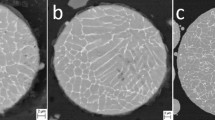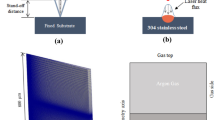Abstract
For many contemporary powder metallurgical applications, spherical powders are preferred. Spherical particles have a lower oxygen content, a better flowability, and their behaviour is—compared to irregular particles—better predictable. The powder production process via melt atomisation can be divided into the steps a. primary breakup into ligaments, b. ligament breakup, and c. secondary breakup and/or spheroidisation, while simultaneously cooling and freezing take place. Apart from thermodynamic conditions during the process, melt properties such as viscosity, density, surface tension, heat capacity, and thermal conductivity will influence the processes around spheroidisation.
As a first step, a 4-force model (viscosity, surface tension, external dynamic, and inertia forces) is applied on the melt droplet to predict the influence of the melt properties on spheroidisation separately. Secondly, the spheroidisation process is calculated for different materials such as Copper, Iron, or Titanium for existing atomisation systems. Finally, suggestions are presented which may help to produce more spherical particles.
Zusammenfassung
Bei vielen zeitgenössischen pulvermetallurgischen Anwendungen werden sphärische Pulver bevorzugt. Sphärische Partikel zeichnen sich durch geringeren Oxidgehalt und bessere Fließfähigkeit aus. Außerdem ist ihr Verhalten – im Vergleich zu ungleichmäßigen Partikeln – besser prognostizierbar. Der Herstellungsprozess von Metallpulver via Schmelzezerstäubung kann in 3 Abschnitte unterteilt werden: a. Primärzerfall in Ligamente, b. Ligamentzerfall und c. Sekundärtropfenzerfall und/oder Sphäroidisierung. Gleichzeitig kühlen die Schmelzetropfen ab und erstarren. Abgesehen von den thermodynamischen Prozessbedingungen wird der Sphäroidisierungsprozess insbesondere von Schmelzeeigenschaften wie Viskosität, Dichte, Oberflächenspannung, Wärmekapazität und thermischer Leitfähigkeit beeinflusst.
In einem ersten Schritt wird ein 4‑Kräfte-Modell (Zähigkeitskraft, Oberflächenkraft, äußere dynamische Kräfte sowie Trägheitskraft) aufgesetzt, um den jeweiligen Einfluss der Materialeigenschaften auf den Sphäroidisierungsvorgang isoliert betrachten zu können. Im zweiten Schritt wird der Sphäroidisierungsprozess für verschiedene Materialien wie Kupfer, Eisen oder Titan berechnet. Schließlich werden Möglichkeiten erörtert, mit denen sphärischere Partikel hergestellt werden können.









Similar content being viewed by others
References
Dombrowski, N.; Johns, W. R.: The aerodynamic instability and disintegration of viscous liquid sheets, Chemical Engineering Science, 18 (1963) no. 3, pp 203–214
Dopler, M.: Production of Spherical Particles—Theory and Practice, Euro PM2019, Maastricht, 2019
Rao, P.: Shape and other properties of gas atomized powders, Ph.D. Thesis, Drexel University, Philadelphia, Pennsylvania, 1973
Dopler, M.: Prediction of particle sizes of gas-atomized metal powders, Ph.D. Thesis, Lehrstuhl für Verfahrenstechnik des industriellen Umweltschutzes, Leoben: University of Leoben, 2017
Rayleigh, L.: On the instability of jets. Proceedings of the London Mathematical Society, 1 (1878), no. 1, pp 4–13
Delplanque, J. P.; Lavernia, E. J.; Rangel, R. H.: Analysis of in-flight oxidation during reactive spray atomization and deposition processing of aluminum, Journal of Heat Transfer, 122 (2000), no. 1, pp 126–133
Lohner, H.; Fritsching, U.; Bauckhage, K.: Melt atomization by heated gases, ILASS-Europe, 2002, p 021
Author information
Authors and Affiliations
Corresponding author
Additional information
Publisher’s Note
Springer Nature remains neutral with regard to jurisdictional claims in published maps and institutional affiliations.
Rights and permissions
About this article
Cite this article
Dopler, M. Influence of Material Properties on the Spheroidisation Process in Gas Atomisation. Berg Huettenmaenn Monatsh 165, 150–156 (2020). https://doi.org/10.1007/s00501-020-00953-8
Received:
Accepted:
Published:
Issue Date:
DOI: https://doi.org/10.1007/s00501-020-00953-8




